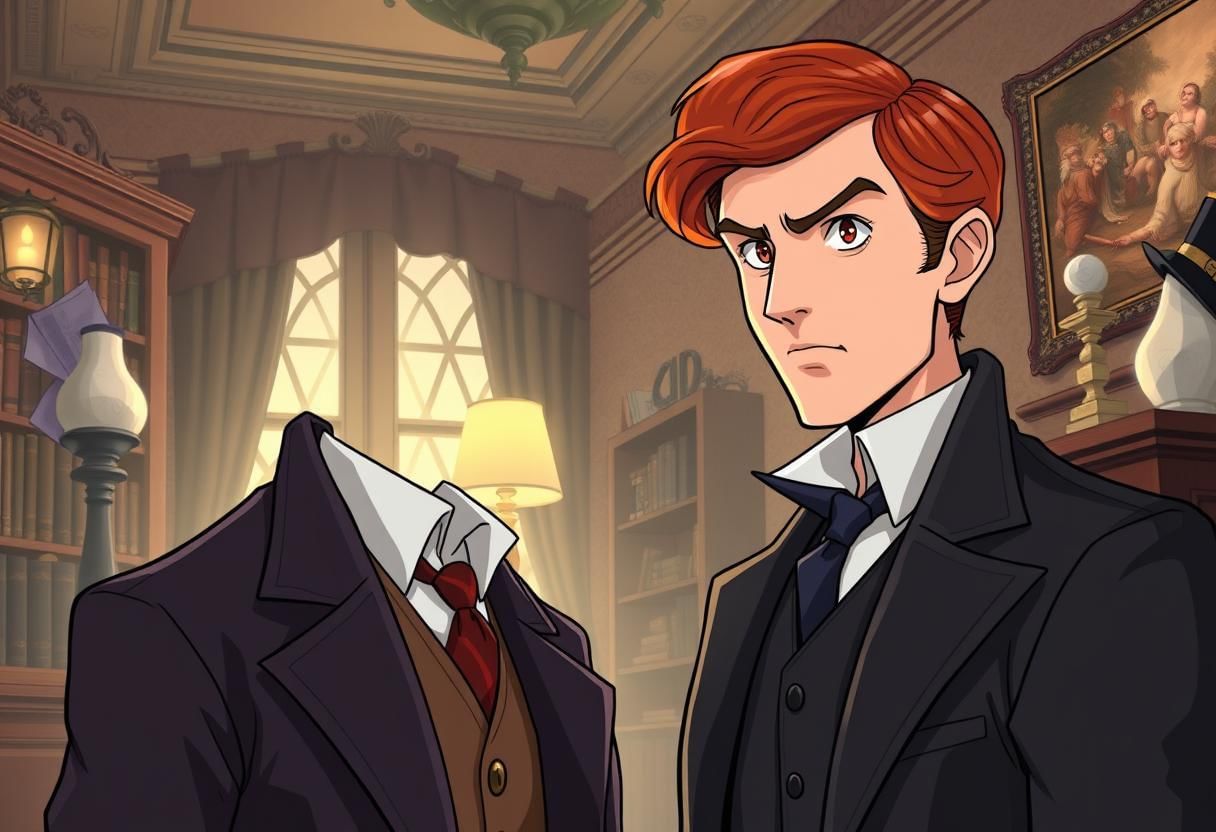The Mystery of The Red-Headed League Chapter Notes | Year 9 English IGCSE (Cambridge) - Class 9 PDF Download
| Table of contents |

|
| The red-headed visitor |

|
| The Assistant |

|
| The End of the League |

|
| Investigating the Street |

|
| The Dark Cellar |

|
| The Solution |

|
The red-headed visitor
The Red-Headed League
 Red-Headed Client
Red-Headed ClientExtract 1
Dr. John Watson arrived at Sherlock Holmes’s apartment to find his friend engaged in conversation with Jabez Wilson, a stout, florid-faced elderly man distinguished by his fiery red hair. Holmes, with his characteristic flair, deduced several facts about Wilson: he had performed manual labor, had been to China, and had recently done significant writing. Wilson, astonished, confirmed these observations.
His larger, more developed right hand betrayed his labor, the shiny cuff of his sleeve hinted at frequent writing, and a peculiar fish tattoo above his wrist pointed to time spent in China. Wilson, seeking Holmes’s help, presented a newspaper advertisement that had sparked his predicament.
The ad, for “The Red-Headed League,” announced a vacancy offering £4 a week for nominal services, open to red-headed men, with applications directed to Duncan Ross on Fleet Street. Holmes, intrigued by the oddity, chuckled and asked Wilson to recount his story. Wilson explained he ran a small business at Coburg Square, once employing two assistants but now managing with just one, Vincent Spaulding, who accepted half wages to work for him.
The Assistant
Extract 2
Jabez Wilson elaborated on his assistant, Vincent Spaulding, describing him as a sharp, capable worker despite not being youthful. Spaulding’s intelligence made him valuable, though Wilson noted his faults, particularly his obsession with photography. Spaulding frequently snapped pictures and retreated to the cellar to develop them, a habit Wilson tolerated due to his otherwise diligent work.
It was Spaulding who brought the Red-Headed League advertisement to Wilson’s attention, excitedly pointing out the opportunity it presented. He explained that the League was founded by a red-headed American millionaire who bequeathed his fortune to support men with similar hair color, offering splendid pay for minimal work. However, only those with bright, blazing red hair qualified. Spaulding’s enthusiasm and apparent knowledge convinced Wilson to apply.
Together, they visited the League’s office, a sparse room with just a table and chairs, where Duncan Ross, a man with even redder hair, inspected Wilson’s locks and promptly hired him. When Wilson hesitated due to his business, Spaulding offered to manage it in his absence. The job required Wilson to copy the Encyclopaedia from ten to two daily for £4 a week, a task he found straightforward but peculiar.
The End of the League
 Mystery Office
Mystery OfficeExtract 3
Wilson began his work for the Red-Headed League with enthusiasm, arriving each morning at ten to copy the Encyclopaedia under Duncan Ross’s supervision. Ross would start him on a section, beginning with the letter A, and then leave him to his task, returning only to check progress.
Each Saturday, Ross paid Wilson four golden sovereigns for his week’s work, a routine that continued unchanged for eight weeks. Wilson left promptly at two each afternoon, satisfied with the easy money. But one morning, he arrived to find the office door locked, a cardboard sign announcing the League’s dissolution.
Staggered by the abrupt end, Wilson sought Holmes’s help, desperate to understand who was behind the League and why they had played what he believed to be a cruel joke. Holmes, intrigued, questioned Wilson about Spaulding, learning he had been employed for a month, chosen for his willingness to work cheaply. Holmes’s excitement grew when Wilson described Spaulding as small, stout, quick, clean-shaven, over thirty, with pierced ears, hinting at a deeper connection to the mystery.
Investigating the Street
 Detective's Pursuit
Detective's PursuitExtract 4
Holmes and Watson ventured to Coburg Square to investigate Wilson’s business and its surroundings. Holmes carefully observed the street, tapping the pavement with his stick to test its structure. At Wilson’s shop, he knocked, and a bright, clean-shaven young man—Vincent Spaulding—answered, promptly giving directions to the Strand when Holmes inquired. Holmes noted Spaulding’s sharpness, revealing he had prior knowledge of him.
Watson assumed Holmes wanted to see Spaulding, but Holmes clarified his focus was on the assistant’s trouser knees, which revealed signs of wear he had anticipated. The pavement tapping, he hinted, was part of his observations, though he withheld further explanation. Turning the corner, they entered a bustling street lined with shops, including a newspaper stand, the City and Suburban Bank, a vegetarian restaurant, and a depot.
Holmes memorized the layout, sensing the case’s seriousness. He requested Watson’s help that night at ten, arranging to meet at Baker Street. There, Watson found Holmes with Peter Jones, a police agent, and Mr. Merryweather, a bank director, setting the stage for a confrontation.
The Dark Cellar
Extract 5
In the cellar of the City and Suburban Bank, Mr. Merryweather led Holmes, Watson, and Jones through a dark passage to a vast space filled with crates and boxes. Holmes, expecting a crime orchestrated by the notorious thief John Clay, examined the floor’s stone cracks with a lantern and magnifying lens, confirming his suspicions.
Merryweather revealed the cellar housed 2,000 napoleons of French gold, explaining the criminals’ interest. Holmes instructed the group to hide behind crates, covering the lantern to plunge the cellar into darkness. The absolute blackness and cold, dank air unnerved Watson, but Holmes remained vigilant, positioning himself behind a crate.
He assured them Clay had only one escape route—back through the house—where Jones had stationed officers. The group settled into a tense, silent wait, their nerves strained as they anticipated the intruders’ arrival, aware of the daring criminals’ potential for violence.
The Solution
Extract 6
As the group waited in the dark cellar, Watson spotted a faint glint of light that grew into a yellow line. A stone slab shifted, revealing a hole through which a boyish face emerged, followed by a second figure. Holmes sprang forward, seizing the first intruder, identified as John Clay, while the second dove back into the hole. Holmes calmly informed Clay his escape was futile, as officers waited at the house. Clay acknowledged his accomplice’s likely capture but remained defiant.
Later, Holmes explained to Watson that the Red-Headed League was a ruse to remove Wilson from his shop daily. Spaulding’s low wages signaled a ulterior motive, and his cellar disappearances suggested tunneling. Holmes’s pavement tapping confirmed the cellar’s direction, and the worn knees of Spaulding’s trousers betrayed hours of digging. Seeing the bank next door, Holmes deduced Clay, alias Spaulding, was tunneling to steal the gold, using the League to distract Wilson while he worked undetected.
Language Focus
In older texts like “The Red-Headed League,” unfamiliar words can challenge readers, but their meanings can often be deduced through context, morphology, and related words. For instance, in the sentence describing Jabez Wilson, “There was nothing remarkable about the man save his blazing red head,” the context of commenting on appearance suggests “remarkable” means distinctive or noticeable. Morphologically, “remarkable” breaks into “re-” (again), “mark” (from the French “marquer,” to note), and “-able” (capable of), implying something worthy of notice. Familiar words like “remark,” “marked,” or “marking” further hint at its connection to observation or distinction. These strategies—using the story’s context, analyzing word structure, and drawing on known related terms—help unlock the meanings of archaic or complex words, enriching the reading experience.
|
9 docs|9 tests
|
FAQs on The Mystery of The Red-Headed League Chapter Notes - Year 9 English IGCSE (Cambridge) - Class 9
| $1. What is the main plot of "The Red-Headed League"? |  |
| $2. Who are the key characters in "The Red-Headed League"? |  |
| $3. What is the significance of the dark cellar in the story? |  |
| $4. How does Sherlock Holmes solve the mystery in "The Red-Headed League"? |  |
| $5. What is the moral or lesson of "The Red-Headed League"? |  |















